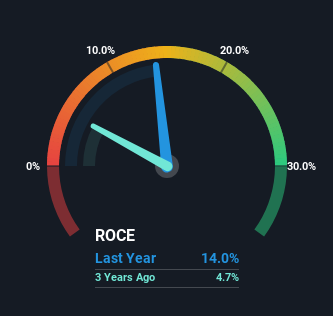
What are the early trends we should look for to identify a stock that could multiply in value over the long term? One common approach is to try and find a company with returns on capital employed (ROCE) that are increasing, in conjunction with a growing amount of capital employed. This shows us that it's a compounding machine, able to continually reinvest its earnings back into the business and generate higher returns. Having said that, from a first glance at Aritzia (TSE:ATZ) we aren't jumping out of our chairs at how returns are trending, but let's have a deeper look.
Understanding Return On Capital Employed (ROCE)
Just to clarify if you're unsure, ROCE is a metric for evaluating how much pre-tax income (in percentage terms) a company earns on the capital invested in its business. To calculate this metric for Aritzia, this is the formula:
Return on Capital Employed = Earnings Before Interest and Tax (EBIT) ÷ (Total Assets - Current Liabilities)
0.14 = CA$198m ÷ (CA$1.9b - CA$527m) (Based on the trailing twelve months to August 2023).
So, Aritzia has an ROCE of 14%. By itself that's a normal return on capital and it's in line with the industry's average returns of 14%.
See our latest analysis for Aritzia

In the above chart we have measured Aritzia's prior ROCE against its prior performance, but the future is arguably more important. If you're interested, you can view the analysts predictions in our free report on analyst forecasts for the company.
What Can We Tell From Aritzia's ROCE Trend?
On the surface, the trend of ROCE at Aritzia doesn't inspire confidence. To be more specific, ROCE has fallen from 22% over the last five years. Although, given both revenue and the amount of assets employed in the business have increased, it could suggest the company is investing in growth, and the extra capital has led to a short-term reduction in ROCE. And if the increased capital generates additional returns, the business, and thus shareholders, will benefit in the long run.
While on the subject, we noticed that the ratio of current liabilities to total assets has risen to 27%, which has impacted the ROCE. Without this increase, it's likely that ROCE would be even lower than 14%. While the ratio isn't currently too high, it's worth keeping an eye on this because if it gets particularly high, the business could then face some new elements of risk.
In Conclusion...
While returns have fallen for Aritzia in recent times, we're encouraged to see that sales are growing and that the business is reinvesting in its operations. In light of this, the stock has only gained 28% over the last five years. So this stock may still be an appealing investment opportunity, if other fundamentals prove to be sound.
Since virtually every company faces some risks, it's worth knowing what they are, and we've spotted 2 warning signs for Aritzia (of which 1 is a bit unpleasant!) that you should know about.
While Aritzia isn't earning the highest return, check out this free list of companies that are earning high returns on equity with solid balance sheets.
New: Manage All Your Stock Portfolios in One Place
We've created the ultimate portfolio companion for stock investors, and it's free.
• Connect an unlimited number of Portfolios and see your total in one currency
• Be alerted to new Warning Signs or Risks via email or mobile
• Track the Fair Value of your stocks
Have feedback on this article? Concerned about the content? Get in touch with us directly. Alternatively, email editorial-team (at) simplywallst.com.
This article by Simply Wall St is general in nature. We provide commentary based on historical data and analyst forecasts only using an unbiased methodology and our articles are not intended to be financial advice. It does not constitute a recommendation to buy or sell any stock, and does not take account of your objectives, or your financial situation. We aim to bring you long-term focused analysis driven by fundamental data. Note that our analysis may not factor in the latest price-sensitive company announcements or qualitative material. Simply Wall St has no position in any stocks mentioned.
About TSX:ATZ
Aritzia
Designs, develops, and sells apparels and accessories for women in the United States and Canada.
High growth potential with excellent balance sheet.
Market Insights
Community Narratives


